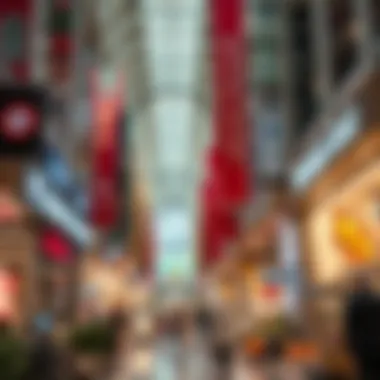Navigating Dubai's Malls: Insights and Trends


Intro
Dubai’s malls are not just shopping hubs; they are vibrant microcosms reflecting the city’s status as a global melting pot. From extravagant luxury outlets to casual family centers, these spaces interweave shopping, dining, and entertainment, contributing significantly to both local culture and the economy. As individuals flock to these retail experiences, it is crucial to understand how these attractions shape the real estate landscape and regional consumer behavior.
Considering the rapid developments in Dubai’s retail sector, it’s evident that the dynamics are constantly evolving. The growing population and a steady influx of tourists play a critical role in driving market fluctuations. For investors, realtors, and developers alike, grasping the current state of malls in Dubai offers insights not just into the retail space but also into broader economic trends that govern consumer habits and preferences.
In various neighborhoods, malls act as social hubs, accommodating a blend of local traditions and modern aspirations. This juxtaposition provides a unique lifestyle essence that could be leveraged by investors looking for promising opportunities in this ever-changing market.
In the following sections, we will dissect key market trends, delve into neighborhood highlights, and explore community amenities that make Dubai’s malls much more than mere shopping destinations. Through in-depth analysis, we seek to enhance understanding for stakeholders keen on navigating this complex yet exciting landscape.
Prelims to Dubai's Retail Scene
Dubai's retail environment is a vibrant tapestry woven from diverse elements that reflect its unique character and ambitions. With a blend of ultramodern architecture, luxury brands, and tailored experiences, malls here are more than just places to shop. They serve as cultural hubs, social hotspots, and are vital drivers of the city's economy.
The importance of understanding Dubai's retail scene cannot be overstated. It showcases not only the evolution of shopping preferences but also the cultural dynamics of a city that attracts millions of visitors each year. For investors, realtors, and developers, grasping the nuances of this market is crucial. The way malls function isn't just about sales figures but involves examining market strategies, customer interactions, and community integration.
Examining this topic will provide insights into how malls impact real estate development, the economies of the locales where they are situated, and even the lifestyle choices of residents and visitors. Additionally, understanding the interplay between retail and the social fabric of Dubai highlights opportunities for growth and innovation in what is now a highly competitive landscape.
Historical Context of Malls in Dubai
The journey of malls in Dubai began with the opening of the Dubai Shopping Centre in the late 1980s. Initially, retail options were limited to souks and small shops. This shopping center marked a turning point, introducing the concept of a one-stop shopping experience. Over the years, Dubai’s malls grew in scale and luxury, with icons like The Dubai Mall and Mall of the Emirates setting benchmarks for both local and global standards.
The evolution of malls coincides with Dubai’s transformation into a global player. As they became larger and more sophisticated, malls started to offer not just retail but also entertainment, dining, and cultural experiences. This shift mirrors the city’s broader progression, reflecting a move from traditional commerce to diverse, experience-driven retail environments.
Current Trends in Retail Shopping
Today, Dubai’s shopping landscape is witnessing several trends, shaped by technological advancements, changing consumer behaviors, and economic fluctuations.
- E-commerce Integration: Many malls are enhancing their physical presence by integrating e-commerce solutions. This allows customers the flexibility to shop online and collect their purchases in-store, a trend that has grown in popularity post-pandemic.
- Sustainability: An increasing number of malls in Dubai are adopting eco-friendly practices, from energy-efficient designs to sustainable product offerings, reflecting a global shift towards environmental responsibility.
- Experiential Retail: Shoppers are hunting for unique experiences rather than just products. Malls are responding by offering events, workshops, and interactive displays, aiming to create memorable outings.
Economic Factors Influencing Malls
Understanding the economic factors that impact malls in Dubai is essential for investors, realtors, and developers. These factors not only dictate operational strategies but also shape the overall experience of consumers. The dynamic landscape of Dubai’s economy, coupled with global trends, creates a complex web of influences that directly affect mall performance and sustainability.
Impact of Global Economic Conditions
Global economic conditions often play a pivotal role in shaping retail landscapes. For Dubai, a cosmopolitan hub reliant on both tourism and trade, shifts on the international stage can resonate deeply within its commercial sectors.
- For example, fluctuations in oil prices can affect disposable incomes in the region.
- Economic downturns or booms in major markets can influence the flow of tourists, particularly from countries such as India and China. This directly impacts foot traffic in local malls allowing only a limited allowance for profits.
- Additionally, geopolitical factors, such as trade policies, can create a hesitant climate for international brands considering entries into the Middle Eastern markets.
As global e-commerce continues to expand, physical malls must find ways to remain relevant. Collaborating with brands to establish exclusive in-store experiences can help mitigate some of these challenges. A well-coordinated approach could be the key to drawing shoppers away from their computer screens and back into the vibrancy of brick-and-mortar locations.
Local Economic Indicators
Local economic indicators serve as a barometer for mall health. These indicators help gauge consumer confidence, spending habits, and overall economic activity.
- Employment Rates: A strong job market tends to correlate with increased consumer spending, nudging shoppers toward upscale malls. Conversely, high unemployment can constrain local retail spending, leaving many boutique stores somewhat in the lurch.
- Tourism Stats: Dubai has established itself as a tourist hotspot. Tracking tourism statistics, including hotel occupancy rates and international visitor numbers, provides insights into potential foot traffic in malls. The more travelers that arrive, the fresher the pool of consumers entering retail spaces.
- Consumer Spending Trends: Monitoring how much people are willing to spend at malls is crucial. For instance, a surge in consumer confidence often fuels spending at luxury and high-end stores, while more cautious economic conditions steer shoppers toward value-oriented retailers.
In light of these factors, understanding local economic conditions can help investors and developers create more adaptive and resilient strategies that appeal to a diverse customer base.
"Malls in Dubai are not just shopping destinations; they are reflections of the city’s economic health. Understanding the underlying economic indicators can lead to more informed and strategic investment decisions."


This focused understanding of both global influences and local economic indicators allows stakeholders to navigate the rapidly evolving landscape of Dubai’s retail market effectively. This insight is foundational for making well-informed decisions that align with both current trends and future opportunities.
Demographics and Consumer Behavior
Understanding the demographics and consumer behavior surrounding malls in Dubai is crucial for grasping the broader retail landscape. This topic offers insight into who frequents these malls, what drives their shopping habits, and how these factors influence both local and international retail strategies. Recognizing the diverse population—from affluent tourists to local residents—can inform business decisions, enhancing the mall experience for a variety of consumers.
Understanding the Target Audience
Dubai's malls cater to a multifaceted audience that includes expatriates, local Emiratis, tourists, and a mix of international visitors. Each group has distinct shopping preferences and behaviors that shape retail offers.
- Expatriates often pursue luxury brands but may also seek products aligned with their home cultures. Understanding this dual desire can drive retailers to adjust their fatestocks, ensuring availability.
- Local Emiratis, known for their strong purchasing power, display a penchant for high-end goods—particularly in jewelry and fashion. Tailoring experiences like exclusive in-store events can entice this demographic further.
- Tourists, lured by the allure of luxury as much as the intriguing cultural experiences, often gravitate toward souvenir shops and global brands seen as status symbols.
Businesses should capitalize on these distinctions by crafting campaigns that speak directly to each audience, ensuring messages resonate.
Changing Preferences in Shopping
Consumer preferences in Dubai's retail sector are evolving, shaped by global trends and local contexts. For instance, the rise of sustainable products reflects a growing awareness among shoppers about environmental impact. Many are now leaning towards brands that prioritize eco-friendly practices. In addition, there's a shift towards experiential retail—where the act of shopping transcends just purchasing items.
Some notable shifts include:
- Digital Integration: With the increasing use of mobile applications for shopping, many consumers prefer to browse online before visiting malls. Shops that incorporate technology into their retail experience—like augmented reality fitting rooms—are seeing heightened interest.
- Health and Wellness: Post-pandemic, there’s been a marked preference for health-oriented products, spurring the popularity of wellness brands. Retailers that promote fitness and wellbeing often find their stocks flying off the shelves.
Over time, these shifts will likely demand that developers and mall operators adapt their spaces and strategies to keep up.
The Role of Tourism in Retail Spaces
Tourism plays a significant role in shaping the shopping landscape of Dubai. With millions of visitors each year, malls are not only shopping venues but also integral components of the tourist experience.
- Attracting Tourists: Malls often serve as designed attractions complete with entertainment facilities, dining options, and cultural events. For example, The Dubai Mall boasts an aquarium and an ice rink, making it a must-visit for tourists seeking more than just shopping.
- Cultural Exchange: Dubai's malls facilitate cultural exchange by showcasing local and international brands, thus appealing to both global shopping habits and local traditions. This blending often enriches the shopping experience, making it more engaging for consumers.
Malls need to embed this sense of tourism within their marketing and branding to keep drawing in crowds, ensuring that they remain vibrant hubs of activity.
Key Malls in Dubai
The vibrant retail landscape of Dubai is epitomized by its various malls, which serve as more than mere shopping venues; they are cultural hubs and social spaces that cater to diverse populations. This section explores some of the most significant malls in the city – understanding them provides insight into not only their commercial value but also their social importance.
As potential investors, developers, or real estate enthusiasts, analyzing these spaces reveals factors such as foot traffic, visitor demographics, and localization trends that drive investment decisions. Each mall has its unique identity, which contributes to the overarching retail ecosystem that Dubai prides itself on.
The Dubai Mall: A Benchmark
The Dubai Mall stands as a monumental benchmark in the commercial landscape. It isn’t just one of the largest malls in the world; it also features an aquarium, an ice rink, and countless dining establishments. The mall attracts millions of visitors from all walks of life.
- Visitor Volume: With over 80 million visitors annually, the sheer number is a testament to its attraction.
- Luxury Retail Offerings: High-end brands like Louis Vuitton and Gucci have flagship stores here.
- Cultural Significance: Situated next to the iconic Burj Khalifa and the Dubai Fountain, it blends retail with a rich visual feast.
Investors often look at the types of stores featured in the mall, the strategic placements of entrances, and the general layout to assess potential returns on investment. As a hub, The Dubai Mall offers a benchmark for both retail experience and commercial success, influencing the development of other malls across the emirate.
Mall of the Emirates: Luxury and Leisure
Mall of the Emirates is another cornerstone in Dubai’s vast retail complex. It is renowned not only for its broad array of luxury boutiques but also for its leisure attractions such as Ski Dubai, the premier indoor ski resort.
- Luxury Shopping Experience: Home to brands like Chanel and Dior, visitors can indulge in shopping lavishly.
- Diverse Facilities: Beyond shopping, the mall houses cinemas and themed restaurants that provide an all-in-one experience.
- Tourist Attraction: The unique allure of its indoor skiing facility draws tourists and families alike, enhancing visitor profiles.
Investment opportunities in this mall are buoyed by its dual emphasis on shopping and leisure. Developers look to this successful blend as a model for emerging retail spaces.


Ibn Battuta Mall: A Cultural Experience
Ibn Battuta Mall stands apart with its themed sections that pay homage to the travels of the historic explorer. Each court represents a different destination, creating a unique environment.
- Cultural Diversity: The layout features areas inspired by China, India, Persia, Egypt, and Tunisia, showcasing the cross-cultural exchange that Dubai embodies.
- Family-Friendly Environment: With attractions such as a cinema and family entertainment centers, it attracts a broad demographic.
- Affordable Retail Options: It provides a balance between luxury goods and more affordable brands, appealing to varying socio-economic groups.
For investors, the cultural theming of the mall opens avenues for experiential marketing strategies, continuously attracting visitors to explore its various thematic spaces.
Dubai Festival City Mall: Integration of Entertainment and Shopping
Dubai Festival City Mall has redefined the notion of retail by seamlessly integrating shopping with entertainment. Known for its impressive waterfront views, it hosts a variety of events throughout the year, enhancing its appeal to both locals and tourists.
- Dynamic Events: The mall is famous for its spectacular shows, such as the IMAGINE show that features a mix of water, light, and fire.
- Diverse Retail Options: Featuring brands across numerous categories, it caters to a well-rounded shopping experience for its visitors.
- Business Opportunities: With the nearby residential and commercial developments, the mall attracts consistent foot traffic that enhances its long-term viability.
Overall, Dubai Festival City Mall represents an excellent case for investors to look at how innovative concepts can drive sustained interest and customer engagement.
Each of these malls adds to Dubai's reputation as a retail capital, embodying luxury, culture, and community all under one roof. They highlight the crucial intersections between shopping, entertainment, and the overall consumer experience, making them worthy of exploration for anyone interested in the city’s retail dynamics.
Retail Offers and Strategies
Understanding the dynamics of retail offers and strategies is crucial for anyone involved in the shopping landscape of Dubai. The intricacies of what a mall offers can significantly dictate its foot traffic and overall performance. As the competition in the retail space becomes fiercer, both the luxury and affordable segments must develop unique strategies that resonate with their target demographics, adjusting to shifting consumer preferences.
Luxury vs. Affordable Retail
In a city like Dubai, where opulence is often part of daily life, luxury retail holds immense sway. Malls like The Dubai Mall showcase esteemed global brands, where brands like Gucci and Louis Vuitton are not just stores – they’re experiences. This allure of luxury often draws high-net-worth individuals and tourists looking to partake in the extravagance that Dubai offers.
However, the affordable retail segment holds its own remarkable significance. With Dubai’s diverse population, there’s a substantial audience that seeks practicality without compromising quality. Stores such as Centrepoint and H&M have carved out a loyal customer base, providing trendy apparel at accessible prices. Retailers must strike a balance, offering high-quality products that suit varying budgets, appealing to a wider audience.
Key Considerations:
- Customer Experience: Luxury retailers emphasize personalization and exclusivity in their offerings. In contrast, affordable brands focus on convenience and accessibility. Both need to ensure that the shopping experience aligns with the expectations of their demographics.
- Brand Collaborations: High-end brands often collaborate with artists or designers to create limited editions, fostering a sense of urgency and exclusivity. Affordable brands may partner with influencers or trendsetters to reach their audiences more effectively.
Experiential Retail Concepts
Dubai's malls are increasingly morphing beyond mere shopping destinations into experiential havens. The modern consumer craves more than just a transaction; they desire moments and memories. Retailers are adapting by crafting environments that provide entertainment alongside shopping.
Experiential retail concepts include interactive installations, pop-up events, and immersive technology. For example, the VR Park in The Dubai Mall allows shoppers to immerse themselves in virtual realities while also engaging in retail therapy. This not only attracts shoppers but also encourages social media shares, amplifying visibility.
Examples of Strategies:
- Pop-Up Stores: Short-term stores that offer limited-time products or experiences can create buzz and urgency among consumers.
- Workshops and Events: Engaging customers through events, such as DIY workshops or fashion shows, can enhance customer loyalty, making them more likely to return.
"The future of retail is not just about what you sell; it is about the experience you create."
The landscape of retail offers in Dubai’s malls exemplifies a deep understanding of market behavior. Striking a balance between luxurious and affordable offerings while enhancing customer experiences through innovative strategies is becoming paramount. For investors and developers, recognizing these trends can pave the way for continued success in this vibrant market.
Future of Malls in Dubai
The evolution of malls in Dubai is not just about brick and mortar; it’s a tapestry woven by changing lifestyle demands, technological advancements, and economic circumstances. Looking ahead, it becomes essential to understand how these shopping centers can adapt and thrive in the face of ongoing change. This section examines the catalysts for development and offers a lens into the potential transformations that await Dubai's retail landscape.
Adapting to E-Commerce Trends


As the digital marketplace burgeons, the physical retail environment faces a significant challenge. E-commerce has redefined consumer habits, making it crucial for malls to rethink their strategies. Once a secondary alternative, online shopping now poses a direct competition that malls cannot afford to overlook.
To maintain foot traffic, malls have started to enhance the in-person shopping experience, creating worlds that cannot be replicated online. Here are a few adaptive strategies:
- Integrating Technology: Malls like The Dubai Mall have deployed augmented reality applications to guide shoppers through their vast selections, a feature that can captivate tech-savvy youths.
- Omni-channel Approaches: Many retailers are offering seamless experiences across online and physical platforms. Consumers expect the ability to buy online and return in-store, reflecting a shift toward more cohesive shopping experiences.
- Hosting Events: By organizing events that engage visitors beyond traditional shopping, like art exhibitions or food festivals, malls attract foot traffic that online retail can't compete with.
"Retail is not dead, but it’s evolving faster than we can imagine."
- Anonymous Retail Expert
Investors must recognize the significance of these shifts. Those who invest in transforming malls into experiential hubs can potentially benefit from their resilience against online competition.
Forecasting Retail Changes
Projecting future trends in retail requires looking at numerous factors. As Dubai continues to grow as a global commercial hub, several trends are likely to shape mall structures and offerings:
- Sustainability Initiatives: Conscious consumerism is on the rise. Malls that prioritize eco-friendly practices, such as energy-efficient designs and sourcing local products, are likely to foster loyalty among environmentally aware customers.
- Community Focus: Malls will likely shift towards being community centers that prioritize local businesses. Creating a sense of belonging can enhance customer loyalty and engage the community.
- Health and Wellbeing: After the pandemic, there is a greater emphasis on health. Future mall designs will incorporate more open spaces, better ventilation, and possibly incorporate wellness facilities.
For additional insights, check resources like Encyclopedia Britannica, Wikipedia, and Reddit to see how evolving retail trends shape consumer behavior.
Investment Opportunities in Retail
The retail landscape in Dubai draws significant interest from investors, primarily due to the city's flourishing economy and its appeal as a shopping paradise. As investors look for avenues to channel their capital, understanding the nuances that govern investment opportunities in retail spaces becomes crucial. This section dissects the factors that investors should consider, the potential benefits of engaging in this sector, and the broader implications of these investments on Dubai’s commercial real estate scene.
Analyzing Current Real Estate Trends
The real estate environment in Dubai is continually in flux, influenced by several elements such as economic indicators, market demand, and shifts in consumer behavior. Developers are now keenly observing the patterns surrounding retail real estate to align their investments accordingly.
A few notable trends shaping the current landscape include:
- Mixed-use developments: More investors are leaning towards properties that blend residential, commercial, and leisure spaces. This approach meets the demands of modern lifestyles and attracts a wide range of visitors.
- Sustainable buildings: With growing awareness around environmental issues, sustainable architecture has become a significant draw. Retail spaces that incorporate green technologies and eco-friendly designs attract socially conscious shoppers and investors.
- Technological integration: Malls that adopt innovative tech—think virtual fitting rooms or mobile payment solutions—are likely to attract more foot traffic. Investors see these developments as a strong indicator of a mall's potential longevity in a digital world.
Tracking these evolving trends helps investors make informed decisions, steering their investments towards properties likely to yield the best returns.
Evaluating Location and Foot Traffic
When it comes to retail, location is everything. Investors must conduct thorough analyses to assess not just the physical attributes of a site, but also the surrounding factors that influence foot traffic. High-traffic areas consistently demonstrate greater potential for success.
Here are key aspects to consider when evaluating location:
- Accessibility: Is the mall easily reachable via public transport or major roads? Strong connectivity can significantly increase shopper visits.
- Nearby Attractions: Malls next to popular attractions or business districts tend to have higher footfalls. For instance, proximity to landmarks like Burj Khalifa or the Dubai Marina can create additional shopper interest.
- Demographics: Understanding the local population's preferences helps in tailoring offerings and marketing strategies to suit the area’s demographics. Investors should analyze age, income levels, and lifestyle choices to gauge potential customer bases.
- Competitor Presence: The existing competition can either be a boon or a bane. Areas with established malls may indicate a healthy demand for retail, but too many similar offerings can dilute market share.
Taking these factors into account can lead to more thoughtful and strategic investment decisions. As the retail sector in Dubai evolves, savvy investors will recognize that understanding the dynamics of location and foot traffic is vital to navigating this bustling market.
Culmination: Insights and Reflections
As we wrap up our exploration of malls in Dubai, it's crucial to reflect on the various themes we've discussed throughout this article. The unique shopping culture in this vibrant city showcases not only the economic dynamics but also a lifestyle that blends leisure and commerce seamlessly.
Summarizing Key Findings
The findings highlight several pivotal aspects:
- Malls as Multifunctional Spaces: They serve not just as places for shopping but also as destinations for entertainment and social interaction. Malls like The Dubai Mall offer experiences beyond simple retail, including art exhibitions and leisure activities.
- Economic Indicators: The health of the mall industry is tied closely to both local and global economies. Factors such as tourism inflows, disposable incomes, and global trade impacts are significant.
- Evolving Consumer Preferences: The shift towards experiential retail is evident; consumers are gravitating towards environments that offer memorable experiences alongside their shopping needs.
- Investment Potential: For investors, the adaptability of malls to incorporate e-commerce trends could represent opportunities for growth and sustainability in a rapidly changing retail landscape.
The Continued Importance of Malls in Urban Development
Malls are not just commercial spaces; they play a critical role in the urban fabric of Dubai. Their architectural designs often reflect cultural identities and become landmarks that contribute to the overall aesthetic of the city. Moreover, nurturing community spaces through malls can lead to positive social interactions among various societal segments.
"Malls serve as social hubs, enhancing community ties while providing a conduit for investment opportunities."
In essence, as Dubai attempts to position itself as a global hub for commerce and leisure, the development and management of malls will be paramount. Thus, for those looking to enter the market—be it through investment or rental, understanding the undercurrents of these retail spaces can unlock many doors.











